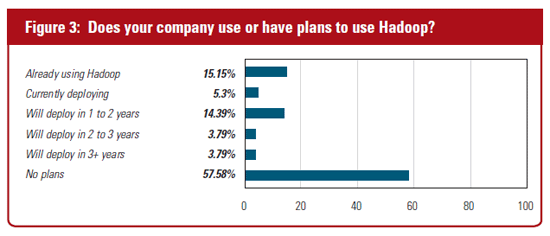This morning, we announced the results of a new survey of database deployments aimed at identifying today’s most prevalent technology adoption trends driving the data platform marketplace and the evolving role of today’s database administrator (DBA). After surveying more than 300 DBA’s and others charged with managing corporate data, we were able to gain deeper insight into the so-called big data movement, including the initial real-world adoption of modern Hadoop and NoSQL technologies, as well as the current usage of traditional relational database technologies.
Before I get into what I think they mean in terms of the big picture and the future of the data and information management industry at large, let’s take a look at some of the key survey findings themselves:
The majority of data under management is structured
Although unstructured data types play an increasing role in the modern data ecosystem, structured data remains the foundation of the information infrastructure in most companies. According to the survey, while management of unstructured data will likely become more prevalent as advanced analytics initiatives continue to gain traction, structured data still makes up 75 percent of data under management for more than two-thirds of organizations, with nearly one-third of organizations not yet actively managing unstructured data at all.
Traditional relational databases remain the focal point of data management efforts
Though the survey reveals a cross-section of database platforms in use across organizations, Oracle (found in 78 percent of orgs) and Microsoft SQL Server (found in 72 percent) remain the most common platforms organizations use to support mission-critical data.
The use of Hadoop and NoSQL is still in nascent stages
While Hadoop and NoSQL are exciting new technologies, their use does not factor into many companies’ plans over the next few years. While the industry adoption of NoSQL and Hadoop (especially in larger companies) has clearly increased, nearly 57 percent of companies have no plans to adopt Hadoop within one to three years, and 56 percent of companies have no plans to adopt NoSQL within one to three years.
Analytics are driving new database implementations
The need to support new analytical use cases, which increasingly involves unstructured data and big data technologies, was cited as the most important factor driving adoption of new database management systems, with the need for greater flexibility and performance closely behind.
So what does this all mean? From my perspective, there are two key takeaways here:
#1: The answer is both
Just about every question I’m asked by customers involves the phrase “which one.” Customers want to know which one they should focus on – structured or unstructured, relational or NoSQL, transactional or social? And as Dell’s survey confirms, the answer, in each case, is very clearly both. Data management best practices in the modern era don’t revolve around one or the other. They don’t revolve around just big data or just transactional data. Data management today is about optimizing, connecting to, integrating and analyzing all of your data, regardless of how big it is or where it resides. The companies that can do that are the ones that will be best positioned for success.
#2: The role of the DBA is evolving
Dell’s survey suggests that the increasing adoption of Hadoop and NoSQL will lead to a change in the role of the database administrator. We found that, overwhelmingly, most DBAs are responsible for managing multiple database instances. Seventy percent of the respondents said the DBAs in their organizations were responsible for managing databases from at least two vendors, and 7 percent of respondents said the DBAs at their companies were responsible for managing databases from five or more vendors. With the growth of data under management and introduction of new technologies, including cloud-based computing, we’re only expecting this trend to keep growing, with the role of the DBA evolving to become increasingly “multilingual.” Gear up, DBAs.
To learn more about the survey, or to review the results in detail, you can view the full report here. And if you have any questions, or just want to chat about information management in general, feel free to drop me a line on Twitter @AlertSource.

